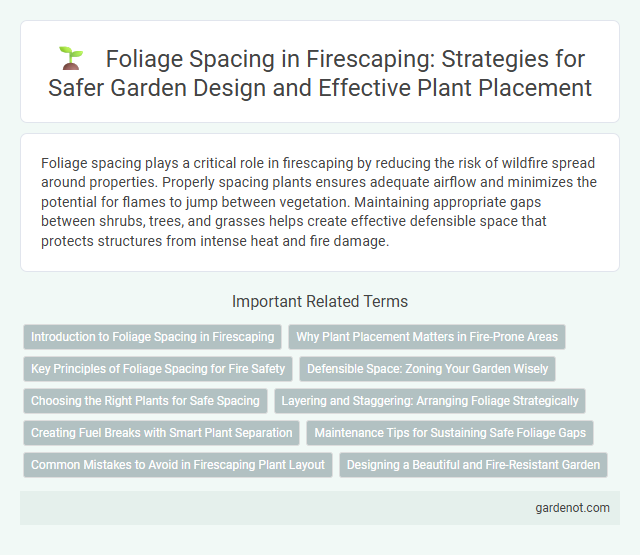Foliage spacing plays a critical role in firescaping by reducing the risk of wildfire spread around properties. Properly spacing plants ensures adequate airflow and minimizes the potential for flames to jump between vegetation. Maintaining appropriate gaps between shrubs, trees, and grasses helps create effective defensible space that protects structures from intense heat and fire damage.
Introduction to Foliage Spacing in Firescaping
Proper foliage spacing in firescaping reduces fire risk by minimizing plant-to-plant fuel continuity, creating defensible zones around structures. Strategic placement of trees, shrubs, and groundcovers with adequate gaps interrupts fire spread and improves access for firefighting efforts. Fire-resistant plants spaced appropriately enhance landscape resilience while maintaining aesthetic and ecological value.
Why Plant Placement Matters in Fire-Prone Areas
Proper foliage spacing is crucial in fire-prone areas to reduce the risk of fire spread by creating defensible space around structures. Strategic plant placement minimizes continuous fuel loads, interrupting fire pathways and lowering heat intensity. Maintaining adequate gaps between trees, shrubs, and ground cover enhances fire resilience and protects property from wildfire damage.
Key Principles of Foliage Spacing for Fire Safety
Adequate foliage spacing reduces fire intensity by limiting fuel continuity and creating defensible space around structures. Maintaining at least 10 feet of horizontal separation between canopy layers and 3 to 5 feet of vertical spacing between shrubs and tree canopies disrupts fire spread. Regular pruning and removal of ladder fuels further minimize ignition risk and enhance wildfire resilience in firescaping design.
Defensible Space: Zoning Your Garden Wisely
Foliage spacing plays a crucial role in creating defensible space by zoning your garden to reduce fire risk effectively. Maintaining adequate gaps between plants and separating vegetation into distinct zones helps slow the spread of fire and provides firefighters with safer access. Strategic plant selection and proper thinning within these zones enhance the garden's overall resilience against wildfires.
Choosing the Right Plants for Safe Spacing
Selecting fire-resistant plants with high moisture content and low oil levels ensures safer foliage spacing in firescaping. Maintaining adequate distance between plants, typically 10 feet or more depending on species flammability, minimizes fire spread risk. Strategic placement of drought-tolerant, firewise shrubs like manzanita and California lilac enhances property protection while preserving landscape aesthetics.
Layering and Staggering: Arranging Foliage Strategically
Layering and staggering foliage in firescaping enhances fire resistance by creating defensible spaces and slowing fire spread. Strategic arrangement of plants with varying heights and densities reduces fuel continuity and increases moisture retention. Proper spacing between layers ensures adequate airflow, minimizing heat transfer and improving overall landscape resilience.
Creating Fuel Breaks with Smart Plant Separation
Creating effective fuel breaks in firescaping involves strategic foliage spacing to interrupt continuous vegetation and reduce fire intensity. Proper plant separation using fire-resistant species with adequate gaps minimizes combustible material connectivity, slowing fire spread. Incorporating moisture-retentive ground covers and regularly maintaining clear safety zones enhances overall landscape fire resilience.
Maintenance Tips for Sustaining Safe Foliage Gaps
Maintaining safe foliage gaps requires regular pruning to prevent overgrowth that can bridge firebreaks and increase wildfire risk. Inspect plant spacing seasonally, ensuring a minimum distance of 30 feet between tree canopies and 10 feet between shrubs for effective fire separation. Utilize drought-resistant and low-flammability species to reduce fuel load and simplify upkeep while preserving a defensible space.
Common Mistakes to Avoid in Firescaping Plant Layout
Foliage spacing errors in firescaping often include overcrowding plants, which fuels fire spread and restricts firebreak effectiveness. Placing flammable species too close together can create continuous fuel ladders, increasing fire risk and intensity. Proper spacing must maintain defensible zones by separating combustible vegetation with non-flammable materials to enhance landscape fire resilience.
Designing a Beautiful and Fire-Resistant Garden
Proper foliage spacing is crucial in designing a fire-resistant garden by creating defensible space that slows fire spread and reduces heat intensity. Maintaining adequate gaps between plants, especially between trees and shrubs, limits fuel continuity and enhances overall garden safety. Thoughtful plant placement combined with fire-resistant species ensures a beautiful landscape that effectively mitigates wildfire risks.
Foliage spacing Infographic

 gardenot.com
gardenot.com